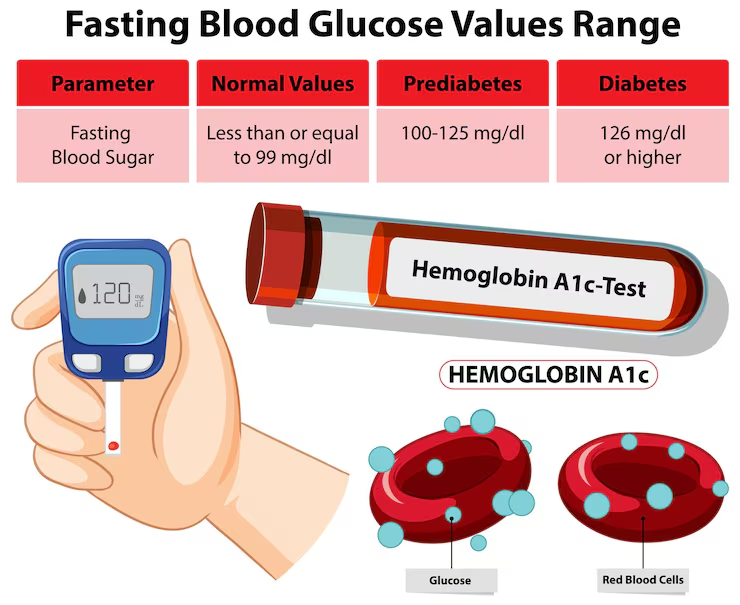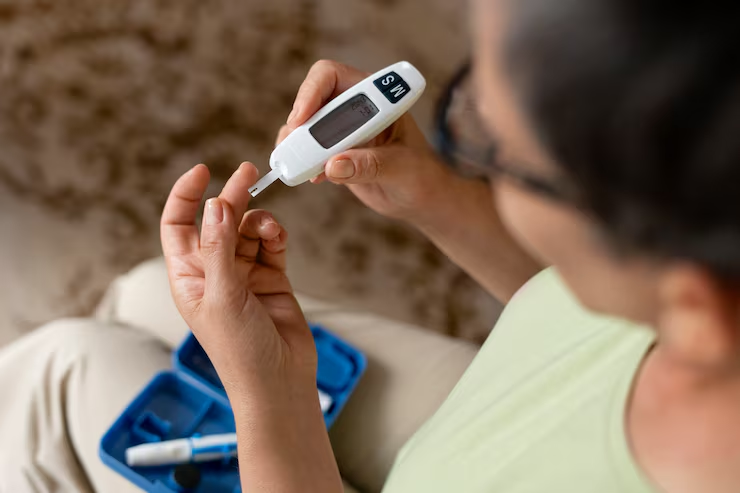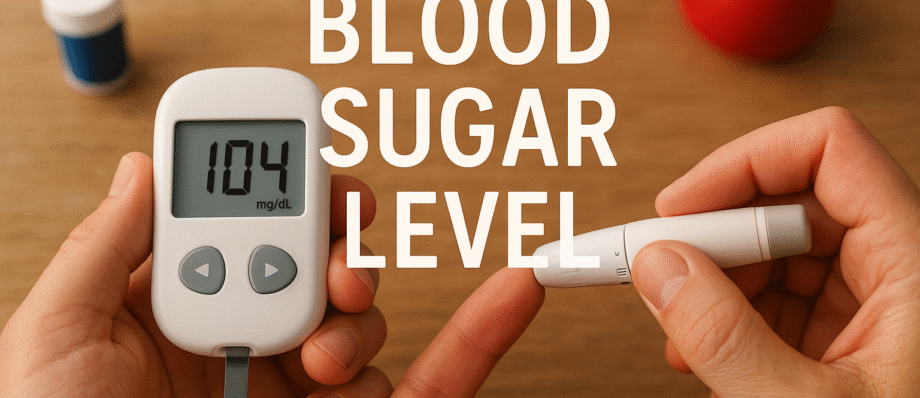Maintaining a healthy body goes far beyond eating right and staying active—it’s about keeping internal systems in balance, especially your blood sugar level. The blood sugar level, also known as blood glucose level, represents the amount of sugar (glucose) circulating in your bloodstream at a given time. Glucose is the main energy source for the body’s cells, and it primarily comes from the food we eat, especially carbohydrates. Your body tightly regulates blood sugar levels through hormones like insulin and glucagon to ensure that energy is available when needed and stored properly when in excess.
When your blood sugar level is within the normal range, your body functions smoothly, supporting concentration, mood, and physical stamina. However, when your blood sugar fluctuates too much—whether it’s too high (hyperglycemia) or too low (hypoglycemia)—it can lead to short-term symptoms like fatigue and confusion, as well as long-term health complications such as diabetes, heart disease, and nerve damage. Monitoring and managing your blood sugar level is therefore one of the most essential aspects of maintaining good health.
This article will explore what exactly blood sugar level means, the factors that affect it, what happens when it becomes imbalanced, and practical ways to maintain it within a healthy range. By the end, you’ll have a comprehensive understanding of how something as simple as glucose in your blood plays a major role in your health, longevity, and energy levels.
10 Informational Points About Blood Sugar Level
1. What Is Blood Sugar Level?
The blood sugar level measures the concentration of glucose in your blood. This measurement is usually expressed in milligrams per deciliter (mg/dL). A normal fasting blood sugar level typically ranges between 70 and 99 mg/dL. When levels rise above or drop below this range, it can signal potential health concerns, including diabetes or hypoglycemia. Regular monitoring helps detect imbalances early and prevents complications.
2. How Blood Sugar Is Regulated
Your body keeps your blood sugar level stable through a complex hormonal system involving the pancreas. Insulin lowers blood sugar by allowing glucose to enter cells for energy, while glucagon raises it by signaling the liver to release stored glucose. Together, these hormones maintain a delicate balance that supports normal metabolic functions and prevents extreme fluctuations.
3. Factors That Affect Blood Sugar Level
Several factors influence blood sugar level, including diet, physical activity, stress, illness, and even sleep. Eating sugary or high-carb foods can cause spikes, while skipping meals or engaging in intense exercise can cause dips. Hormonal changes, medications, and dehydration also play a role in how blood sugar fluctuates throughout the day.
4. Normal Ranges of Blood Sugar Levels
Knowing your normal blood sugar level ranges helps identify potential problems early.
- Fasting (before eating): 70–99 mg/dL
- After eating (1–2 hours): Less than 140 mg/dL
- Pre-diabetes: 100–125 mg/dL (fasting)
- Diabetes: 126 mg/dL or higher (fasting)
These numbers are general guidelines, and individual targets may vary depending on age, health condition, and doctor recommendations.
5. The Role of Insulin in Blood Sugar Management
Insulin is a hormone that acts as a key, unlocking cells to allow glucose to enter and be used for energy. When insulin isn’t produced properly or the body becomes resistant to it, blood sugar levels rise, leading to diabetes. Maintaining insulin sensitivity through a healthy diet and regular exercise helps stabilize blood sugar and supports metabolic health.
6. Diet and Nutrition’s Impact
The foods you eat have a direct effect on your blood sugar level. Complex carbohydrates, fiber-rich foods, and healthy fats slow glucose absorption, preventing sharp spikes. In contrast, refined sugars and processed foods cause rapid increases in blood sugar. Balancing meals with proteins, vegetables, and whole grains helps maintain steady glucose levels throughout the day.
7. Exercise and Physical Activity
Regular exercise is one of the most effective ways to regulate blood sugar level naturally. Physical activity increases insulin sensitivity, allowing your cells to use glucose more efficiently. Even light activities such as walking after meals can significantly reduce post-meal glucose spikes and improve long-term metabolic control.
8. Stress and Blood Sugar
Stress has a surprising impact on blood sugar level. When you’re stressed, your body releases cortisol and adrenaline—stress hormones that trigger glucose release into the bloodstream. This is part of the “fight or flight” response, but chronic stress can keep blood sugar levels elevated. Managing stress through mindfulness, relaxation, and proper sleep can help maintain healthy glucose control.
9. The Importance of Hydration
Dehydration can cause an increase in blood sugar level because the blood becomes more concentrated, and the kidneys have to work harder to remove excess sugar. Drinking enough water helps the body flush out excess glucose through urine and maintain balanced hydration levels, which is vital for those managing diabetes or high blood sugar.
10. Monitoring and Testing Blood Sugar
Monitoring your blood sugar level regularly is essential, especially if you have diabetes or are at risk. Home glucose monitors and continuous glucose monitoring (CGM) devices can help track patterns throughout the day. This information allows for better decision-making about diet, medication, and activity levels, leading to improved overall control.

Blood Sugar Level Leads To? 8 Major Health Implications
1. Type 2 Diabetes
Chronically elevated blood sugar level is one of the main causes of Type 2 diabetes. Over time, the body becomes resistant to insulin, making it difficult for cells to absorb glucose. This leads to persistently high sugar levels that can damage organs and tissues.
2. Heart Disease
High blood sugar levels can damage blood vessels and contribute to plaque buildup in arteries, increasing the risk of heart attack and stroke. People with uncontrolled blood sugar often experience higher cholesterol and triglyceride levels, compounding cardiovascular risks.
3. Kidney Damage (Nephropathy)
When blood sugar level remains high, the kidneys are forced to filter too much blood, causing the small filtering units (nephrons) to weaken over time. This can lead to kidney disease or even kidney failure if not managed properly.
4. Nerve Damage (Neuropathy)
Elevated blood sugar level can damage nerves throughout the body, particularly in the hands and feet. This can cause numbness, pain, or tingling sensations. Peripheral neuropathy is one of the most common complications of long-term diabetes.
5. Vision Problems (Retinopathy)
High blood sugar levels can damage the tiny blood vessels in the eyes, leading to diabetic retinopathy, cataracts, or even blindness. Regular eye exams and good blood sugar management are key to preventing vision loss.
6. Slow Wound Healing
Excessive blood sugar level impairs the immune system’s ability to heal wounds efficiently. This increases the risk of infections and complications, particularly in people with diabetes.
7. Weight Gain and Fatigue
Unbalanced blood sugar level often leads to cravings for sugary foods, causing weight gain and energy crashes. Over time, this creates a vicious cycle of overeating and fatigue, which further disrupts metabolic balance.
8. Mental Health Effects
Fluctuating blood sugar levels can also affect mood and cognition. Many people experience irritability, anxiety, or difficulty concentrating when glucose levels are unstable. Long-term imbalances can even increase the risk of depression.

Conclusion
Understanding your blood sugar level is a crucial part of taking charge of your health. It’s more than just a number on a test—it’s an indicator of how well your body processes and utilizes energy. When your blood sugar is stable, your body functions optimally, you feel more energetic, and your mind stays sharp. But when it’s imbalanced, the effects can ripple across every system in your body.
By making informed lifestyle choices—such as eating balanced meals, exercising regularly, staying hydrated, and managing stress—you can maintain a healthy blood sugar level naturally. Monitoring your glucose regularly also gives you valuable insight into how your body responds to different foods and activities, allowing you to make data-driven decisions about your well-being.
1. What is the normal blood sugar level for a healthy adult?
For a healthy adult, maintaining a normal blood sugar level is essential for the body to function properly. The fasting blood sugar level—which means the level measured after not eating for at least 8 hours—should ideally be between 70 and 99 mg/dL. This range indicates that your body is effectively using insulin to transport glucose into cells for energy.
After eating, your blood sugar level naturally rises as your digestive system breaks down carbohydrates into glucose, which then enters your bloodstream. However, for most healthy individuals, the post-meal (or postprandial) blood sugar level should stay below 140 mg/dL two hours after eating. This shows that your body is producing enough insulin to manage the temporary rise in glucose levels.
If your readings are consistently above these numbers, it may indicate prediabetes or diabetes, which require medical evaluation. On the other hand, levels that are too low (below 70 mg/dL) can signal hypoglycemia. Regularly monitoring your blood sugar level can help identify early imbalances before they turn into more serious health issues. Many people use home glucose meters or continuous glucose monitors to track patterns throughout the day, especially those with metabolic or endocrine concerns.
2. How often should I check my blood sugar level?
How frequently you should check your blood sugar level depends on your individual health status, lifestyle, and whether you have any existing medical conditions such as diabetes or prediabetes.
For healthy adults who don’t have symptoms or risk factors for diabetes, testing once a year during routine medical checkups is generally sufficient. This allows your healthcare provider to ensure that your blood sugar level remains within a normal range and to detect early signs of metabolic issues if they appear.
However, blood sugar level if you are living with diabetes, prediabetes, or insulin resistance, monitoring your blood sugar level becomes far more important. People with Type 1 diabetes may need to test multiple times a day—before meals, after meals, before bedtime, and sometimes even during the night—to ensure their insulin dosage is appropriate. Those with Type 2 diabetes might check once or twice daily, especially if they’re adjusting medications or diet.
It’s also recommended to test your blood sugar level more often when you’re sick, under stress, trying a new meal plan, or changing medications. The goal is to understand how your body responds to different foods, activities, and emotional states so that you can manage your glucose effectively. Continuous glucose monitoring (CGM) devices are an excellent option for people who want real-time insights into their blood sugar trends throughout the day and night.
3. Can diet alone control blood sugar levels?
For many people, diet plays a powerful role in controlling blood sugar level, and in some cases, it can be managed effectively through nutrition alone—especially in early stages of prediabetes or mild Type 2 diabetes. The foods you eat directly influence how quickly glucose enters your bloodstream, and making mindful dietary choices can help prevent sudden spikes and drops in blood sugar.
A balanced diet that includes high-fiber foods, lean proteins, healthy fats, and complex carbohydrates is key to maintaining stable glucose levels. Foods such as whole grains, legumes, non-starchy vegetables, nuts, seeds, and lean meats digest slowly, preventing rapid increases in blood sugar level. In contrast, refined carbohydrates, sugary snacks, and processed foods can cause blood sugar to rise quickly, putting strain on your insulin response.
4. What foods can quickly raise blood sugar level?
Certain foods are known to rapidly increase blood sugar level because they are digested and absorbed quickly, flooding the bloodstream with glucose in a short period of time. These foods typically have a high glycemic index (GI), meaning they cause a sharp and immediate rise in blood glucose after consumption.
Common examples include sugary snacks and desserts, such as candy, pastries, cakes, and cookies. White bread, white rice, and pasta made from refined flour also have a high glycemic index, as they lack fiber and other nutrients that help slow digestion. Sweetened beverages—like sodas, fruit juices, energy drinks, and flavored coffees—are another major culprit, as they deliver large amounts of sugar with little to no nutritional value.
Even some seemingly healthy foods, such as instant oatmeal or flavored yogurt, can spike your blood sugar level if they contain added sugars. Simple carbohydrates are broken down quickly by the body, causing an immediate rise in glucose and a rapid release of insulin. This can result in an energy crash later on, leaving you tired and craving more sugar.
For people with diabetes or insulin resistance, it’s important to be mindful of portion sizes and choose low-glycemic foods whenever possible. Substituting whole grains for refined ones, eating fruits with their natural fiber intact, and pairing carbohydrates with protein or healthy fats can help keep your blood sugar level stable even after eating.

5. Can stress increase my blood sugar level?
Yes, stress can significantly impact your blood sugar level, often in ways people don’t immediately realize. When you experience physical or emotional stress, your body releases stress hormones such as cortisol and adrenaline. These hormones prepare you for the “fight or flight” response by signaling your liver to release stored glucose into the bloodstream, giving your body a quick source of energy.
6. What are the symptoms of low blood sugar level?
A low blood sugar level, medically known as hypoglycemia, occurs when glucose in your bloodstream drops below 70 mg/dL. Since glucose is the body’s primary source of energy—especially for the brain—low blood sugar can cause a variety of uncomfortable and even dangerous symptoms.
The early signs of hypoglycemia include shaking or trembling, sweating, dizziness, irritability, hunger, and rapid heartbeat. You might also experience blurred vision, confusion, or difficulty concentrating as your brain struggles to get enough fuel. If your blood sugar level continues to fall, you https://en.wikipedia.org/wiki/Tremormay become weak, disoriented, or even lose consciousness in severe cases.
1. What is the normal blood sugar level for a healthy adult?
For a healthy adult, maintaining a normal blood sugar level is essential for the body to function properly. The fasting blood sugar level—which means the level measured after not eating for at least 8 hours—should ideally be between 70 and 99 mg/dL. This range indicates that your body is effectively using insulin to transport glucose into cells for energy.
2. How often should I check my blood sugar level?
How frequently you should check your blood sugar level depends on your individual health status, lifestyle, and whether you have any existing medical conditions such as diabetes or prediabetes.
For healthy adults who don’t have symptoms or risk factors for diabetes, testing once a year during routine medical checkups is generally sufficient. This allows your healthcare provider to ensure that your blood sugar level remains within a normal range and to detect early signs of metabolic issues if they appear.
3. Can diet alone control blood sugar levels?
For many people, diet plays a powerful role in controlling blood sugar level, and in some cases, it can be managed effectively through nutrition alone—especially in early stages of prediabetes or mild Type 2 diabetes. The foods you eat directly influence how quickly glucose enters your bloodstream, and making mindful dietary choices can help prevent sudden spikes and drops in blood sugar.
A balanced diet that includes high-fiber foods, lean proteins, healthy fats, and complex carbohydrates is key to maintaining stable glucose levels. Foods such as whole grains, legumes, non-starchy vegetables, nuts, seeds, and lean meats digest slowly, preventing rapid increases in blood sugar level. In contrast, refined carbohydrates, sugary snacks, and processed foods can cause blood sugar to rise quickly, putting strain on your insulin response.
4. What foods can quickly raise blood sugar level?
Certain foods are known to rapidly increase blood sugar level because they are digested and absorbed quickly, flooding the bloodstream with glucose in a short period of time. These foods typically have a high glycemic index (GI), meaning they cause a sharp and immediate rise in blood glucose after consumption.
Common examples include sugary snacks and desserts, such as candy, pastries, cakes, and cookies. White bread, white rice, and pasta made from refined flour also have a high glycemic index, as they lack fiber and other nutrients that help slow digestion. Sweetened beverages—like sodas, fruit juices, energy drinks, and flavored coffees—are another major culprit, as they deliver large amounts of sugar with little to no nutritional value.
Even some seemingly healthy foods, such as instant oatmeal or flavored yogurt, can spike your blood sugar level if they contain added sugars. Simple carbohydrates are broken down quickly by the body, causing an immediate rise in glucose and a rapid release of insulin. This can result in an energy crash later on, leaving you tired and craving more sugar.
5. Can stress increase my blood sugar level?
Yes, stress can significantly impact your blood sugar level, often in ways people don’t immediately realize. When you experience physical or emotional stress, your body releases stress hormones such as cortisol and adrenaline. These hormones prepare you for the “fight or flight” response by signaling your liver to release stored glucose into the bloodstream, giving your body a quick source of energy.
Emotional stress, such as anxiety, work pressure, or personal challenges, can also trigger unhealthy coping mechanisms like overeating, skipping meals, or consuming comfort foods high in sugar and fat—all of which further affect your blood sugar level.

6. What are the symptoms of low blood sugar level?
A low blood sugar level, medically known as hypoglycemia, occurs when glucose in your bloodstream drops below 70 mg/dL. Since glucose is the body’s primary source of energy—especially for the brain—low blood sugar can cause a variety of uncomfortable and even dangerous symptoms.
The early signs of hypoglycemia include shaking or trembling, sweating, dizziness, irritability, hunger, and rapid heartbeat. You might also experience blurred vision, confusion, or difficulty concentrating as your brain struggles to get enough fuel. If your blood sugar level continues to fall, you may become weak, disoriented, or even lose consciousness in severe cases.

